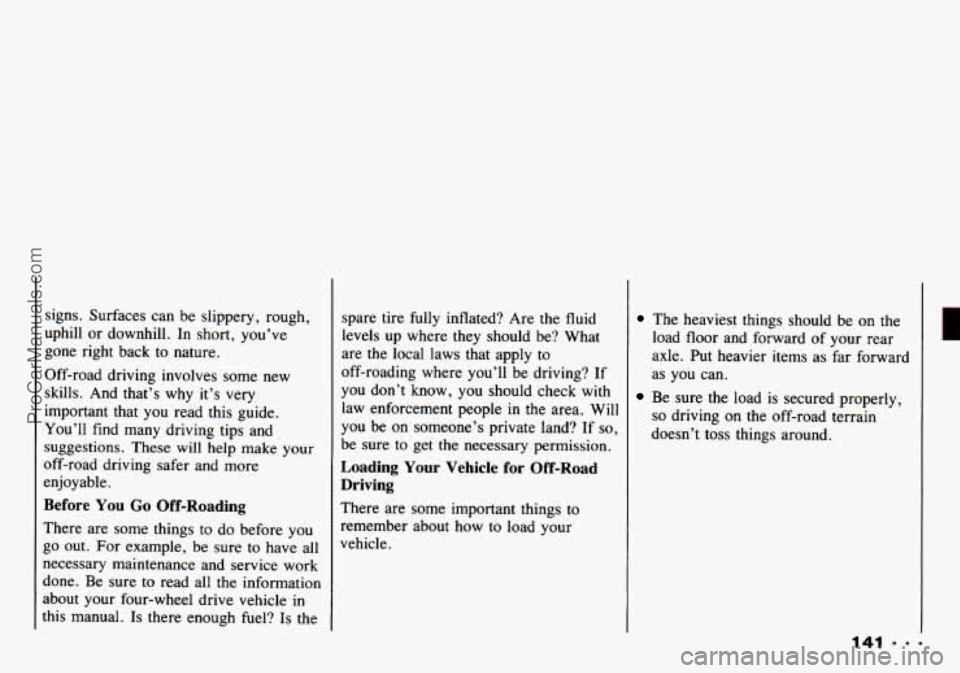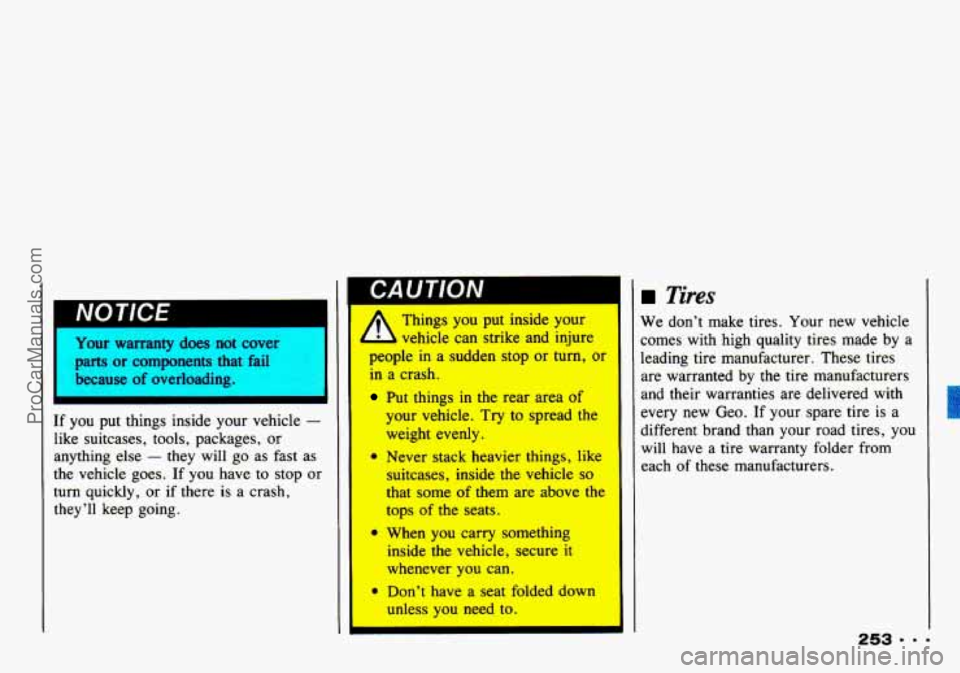Page 143 of 339

signs. Surfaces can be slippery, rough,
uphill or downhill. In short, you’ve
gone right back to nature.
Off-road driving involves some new
skills. And that’s why
it’s very
important that you read this guide.
You’ll find many driving tips and
suggestions. These will help make your
off-road driving safer and more
enjoyable.
Before You Go Off-Roading
There are some things to do before you
go out. For example, be sure to have all
necessary maintenance and service work
done. Be sure
to read all the information
about your four-wheel drive vehicle in
this manual.
Is there enough fuel? Is the spare
tire fully inflated? Are the fluid
levels up where they should be? What
are the local laws that apply to
off-roading where you’ll be driving? If
you don’t
know, you should check with
law enforcement people in the area. Wil
you be on someone’s private land?
If so
be sure to get the necessary permission.
Loading Your Vehicle for Off-Road
Driving
There are some important things to
remember about how to load your
vehicle.
The heaviest things should be on the
load floor and forward of your rear
axle. Put heavier items as far forward
as you can.
Be sure the load is secured properly,
so driving on the off-road terrain
doesn’t
toss things around.
ProCarManuals.com
Page 212 of 339
The jack handle is under the driver’s
seat.
.210
Start with the jack (A), jack handle (B)
and wheel wrench (C).
The spare tire is mounted on your
tailgate. Pull the cover off of the spare
tire.
ProCarManuals.com
Page 213 of 339
Insert your key into the wheel lock and
pull the wheel lock
off.
Remove wheel nuts with the wheel
wrench.
Remove the spare tire from the
mounting bracket and place it near your
flat tire.
Attach the jack handle to the jack bolt.
Rotate the jack handle clockwise (to the
right). That will raise the lift head a
little. Using
the wheel wrench, loosen all the
wheel nuts. Don’t remove them yet.
211
ProCarManuals.com
Page 214 of 339
Problems on the Road
Under the vehicle near each wheel,
there are bosses in the vehicle’s rocker
flange. Position the jack and raise the
jack head until
it fits firmly onto the
bosses nearest the flat tire.
Do not raise
the vehicle yet.
I
A Getting under a vehicle when
d it is jacked up is dangerous. If
LII~ vehicle slips off the jack, you
could be badly injured or killed.
Never get under
a vehicle when it
is supported only by a jack.
. .212
Raising your vehicle with the jack
improperly positioned will damage
the vehicle
or may allow the
vehicle to fall off the jack. Be sure
to fit the jack lift head into the
proper location before raising your
vehicle. Raise
the vehicle
by rotating the wheel
wrench clockwise. Raise the vehicle far
enough
so there is enough room for the
spare tire to
fit.
ProCarManuals.com
Page 215 of 339
c
Remove all the wheel nuts and take off
the
flat tire.
r '_ .-
Rust or dirt on the wheel, or
on the parts to which it is
fastened, can make the wheel nuts
become loose after a time. The
wheel could come off and cause an
accident. When you change a
wheel, remove any rust or dirt
from the places where the wheel
attaches
to the vehicle. In an
emergency, you can use a cloth or
a paper towel to do this; but be
sure to use a scraper or wire brush
later, if you need to, to get all the
rust or dirt off.
- =
Remove any rust or dirt from the wheel
bolts, mounting surfaces or spare wheel.
Place the spare on the wheel mounting
surface.
ProCarManuals.com
Page 255 of 339

NOTICE I
Your warranty does not cover
parts or components that fail
because of overloading.
If you put things inside your vehicle -
like suitcases, tools, packages, or
anything else - they will go as fast as
the vehicle goes. If you have to stop or
turn quickly, or if there is a crash,
they’ll keep going. Things
you put inside your
vehicle
can strike and injure
people
in a sudden stop or turn, or
in a crash.
Put things in the rear area of
your vehicle. Try to spread the
weight evenly.
* Never stack heavier things, like
suitcases, inside the vehicle so
that some of them are above the
tops
of the seats.
* When you carry something
inside the vehicle, secure it
whenever
you can.
9 Don’t have a seat folded down
unless you need to.
Tires
We don’t make tires. Your new vehicle
comes with high quality tires made by a
leading tire manufacturer. These tires
are warranted by the tire manufacturers
and their warranties are delivered with
every new
Geo. If your spare tire is a
different brand than your road tires, you
will have
a tire warranty folder from
each
of these manufacturers.
253 9 9 .
ProCarManuals.com
Page 258 of 339

Service & Appearance Care
I
- 256
If your spare wheel does not match your
other wheels, you may want to use this
pattern.
After the tires have been rotated, adjust
the front and rear inflation pressure as
shown
on the Tire-Loading Information
label. Make certain that all wheel nuts
are properly tightened. See “Wheel Nut
Torque’’ in the Index.
CA U TION
A
Rust or dirt on a wheel, or on
the parts
to which it is
fastened, can make the wheel nuts
become loose after a time. The
wheel could come off and cause an
accident. When you change a
wheel, remove any rust or dirt
from places where the wheel
attaches to the vehicle. In an
emergency, you can use
a cloth or
paper towel to
do this; but be sure
to use a scraper or wire brush
later,
if you need to, to get all the
rust or dirt
off. (See “Changing a
Flat Tire” in the Index.)
I
When It’s Time for New Tires
One way to tell when it’s time for new
tires is to check the treadwear
indicators, which will appear when your
tires have only
2/32 inch (1.6 mm) or
less of tread remaining.
You need a new tire if
You can see the indicators at three
You can see cord or fabric showing
The tread or sidewall is cracked, cut
places around
the tire.
through the tire’s rubber.
or snagged deep enough to show cord
or fabric.
ProCarManuals.com